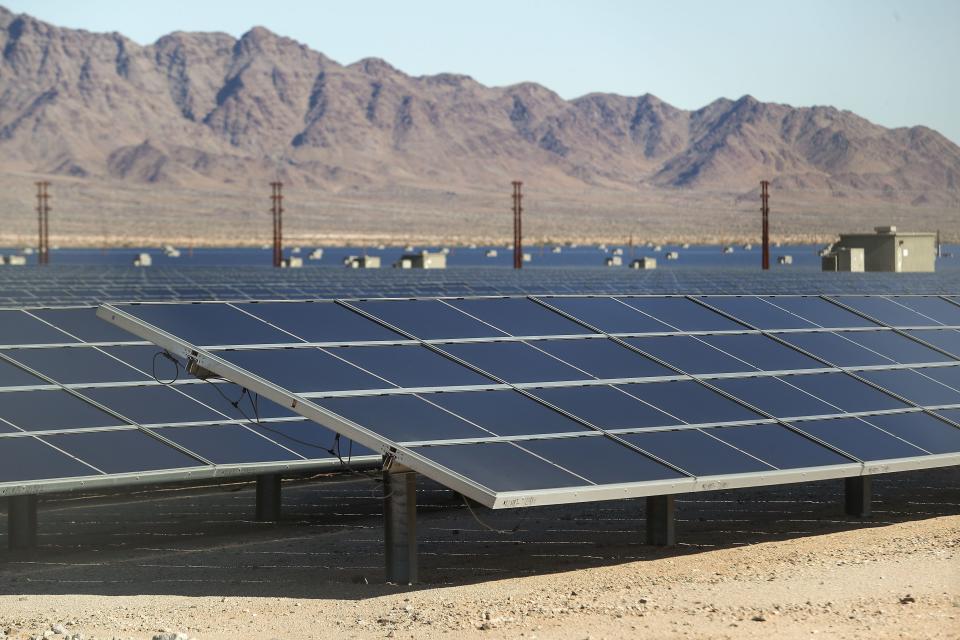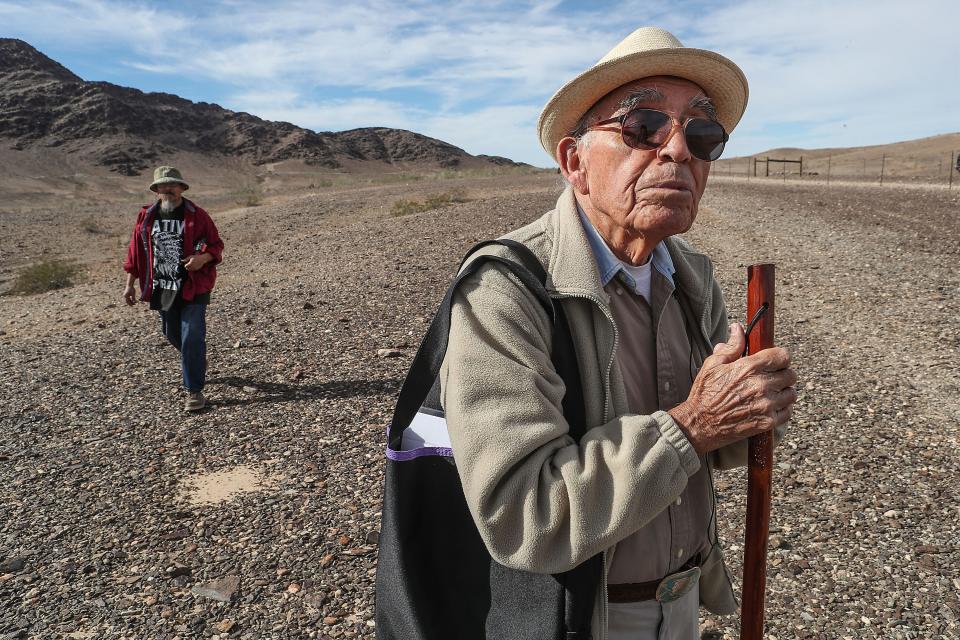$2.5 million of Inflation Reduction Act funds put toward finding desert tribal sacred sites
- Oops!Something went wrong.Please try again later.
The U.S. Bureau of Land Management announced Tuesday that $2.5 million in Inflation Reduction Act funds will be invested in a California desert cultural landscape study and predictive model to better identify potentially destructive impacts of renewable energy development on tribal ancestral lands and other significant landscapes.
Critics and advocates alike of large-scale renewables said the study effort was years behind schedule. Dozens of projects have already been built along the Interstate 10 in Riverside County, on former farm fields in Kern County and elsewhere.
The work has two aims, the agency says: to significantly improve solar and wind project planning and timelines, while minimizing impacts to cultural resources across a broad geographic area.
“These historic investments from President Biden’s Investing in America agenda will support our ability to deploy clean energy, while protecting vital cultural resources in the California desert,” said BLM California State Director Karen Mouritsen. “The BLM is proud to support locally led and locally designed efforts to better understand the impacts on tribal and cultural resources.”
Asked how predictive modeling would be done, BLM Palm Springs spokeswoman Michelle Van Der Linden said in an email that it will use existing data on tribal cultural resources discovered through previous surveys throughout its California desert district, which spans millions of acres in portions of seven inland counties.

"By comparing landscape features and vegetation and additional physical features on the ground, BLM can use these existing data points to predict where there may be concentrations of cultural resources," she said.
She said that via the model, "an application (for a renewable project) filed on public land thought to be a site highly likely to hold cultural resources may be avoided, and will aid applicants with resource avoidance during the initial planning pre-application process."
While certain zones in a sweeping, 10-million-acre California Desert Renewable Energy Conservation Plan have been identified for large-scale renewable projects, such as along Interstate 10 in eastern Riverside County, many of the areas are also longtime ancestral lands for dozens of tribes and bands. There have been clashes over project siting, and vociferous objections to some projects from area tribal members and environmentalists.
One of the first large solar projects in the Sonoran and Mojave deserts, the Genesis Solar Project north of the freeway, bulldozed through historic trails, burial sites and important cultural artifacts. It was approved during the Obama administration and constructed over the objections of the Colorado River Indian Tribes, known as CRIT, and the Fort Mojave Indian Tribe.
Representatives of area tribes did not immediately return requests for comment on Tuesday's announcement. But tribal officials and some environmentalists have pushed hard for such a study and other, more comprehensive reviews prior to bulldozing of fragile desert landscapes, not just for renewables, but for drilling for gold and other minerals in areas where tribes have lived and traveled for centuries.
"We are happy to see the BLM acknowledging the importance of cultural landscapes and look forward to the positive outcomes this may bring with respect to tribal preservation efforts." said T. Robert Przeklasa, executive director of the Native American Land Conservancy.
"This Cultural Landscape Study is long overdue," said Ileene Anderson, senior scientist with the Center for Biological Diversity. "The BLM needs to fully engage all tribes with cultural landscapes in the DRECP and not just for renewable energy projects."
She said, "The Genesis solar project was a nightmare for the tribes."
BLM officials said the cultural landscape study and predictive model is being developed in consultation with California tribes and the California State Historic Preservation Office to fulfill the requirements outlined in a "Section 106 Programmatic Agreement" in the broader desert conservation plan.
Checking boxes or detailed consultation?
"Both efforts will identify resources of religious and cultural significance in a way that enhances renewable energy project siting and avoids resource conflicts. The result will be a more efficient and predictable Section 106 process that will significantly improve project planning and timelines, while minimizing impacts to cultural resources across a broad geographic area," said Van Der Linden. "The study is an important step to better understanding how tribes have comprehensively used the landscape since time immemorial."
Section 106 is a portion of the 1966 National Historic Preservation Act that requires reviews of potential development in historic sites. Shannon Eddy with the Large-Scale Solar Association, a trade group, said she understood a study like the one for which funds were announced Tuesday had been in the works since 2016.
Eddy said, "We hope they're serious about enhancing renewable energy siting. We're eager to see forward progress."
A 2021 amendment to include a landscape study was also made to the programmatic agreement.

Anderson said for years, BLM has simply mailed form letters to tribes about large projects on or near ancestral lands, to check off a box on its legally required consultations between the U.S. government and tribal nations. BLM spokeswoman Van Der Linden disputed that, saying in an email, "The BLM routinely meets and consults with tribes on projects and BLM programs at large."
Since 2009, dozens of renewable energy projects have been approved by state and federal agencies in the southern California desert. The Biden administration is pushing to streamline such projects on public lands across the West, aiming to reduce greenhouse gas emissions from coal and natural gas-fueled projects and slow worsening climate change.
Tribal officials and environmentalist have said they're not opposed to renewables, but local impacts must be recognized and avoided, and many say existing rooftops, parking lots, brownfield sites and even water canals would be preferable sites. Industry groups and some larger environmental groups say both rooftop and large-scale projects are needed to ratchet down harmful emissions.
As of this year, there are 78 authorized large-scale solar, wind and geothermal facilities in California alone. As of this week, there are 22 pending solar-related applications and one wind project with pending right-of-way approvals.
Janet Wilson is senior environment reporter for The Desert Sun and co-authors USA Today Climate Point. She can be reached at jwilson@gannett.com
This article originally appeared on Palm Springs Desert Sun: Feds invest $2.5 million to better identify desert tribal sacred sites

